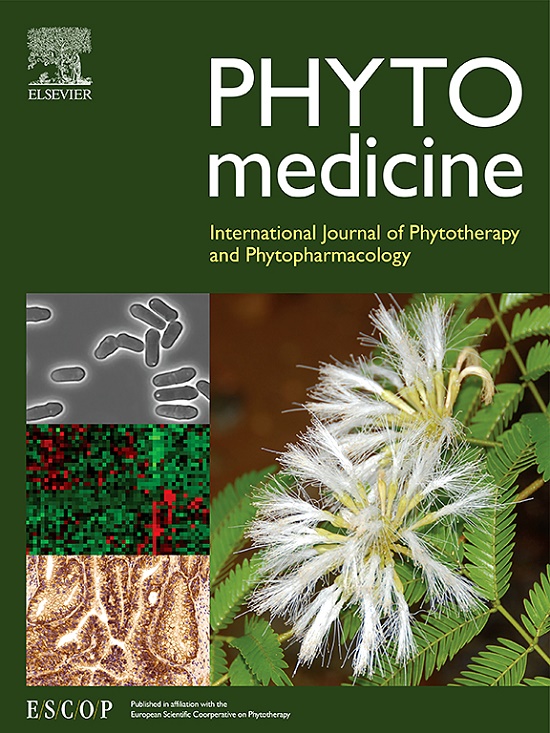头孢噻肟通过靶向TRIB3-FOXO3-FOXM1轴抑制自噬,使胃癌细胞对化疗敏感。
IF 6.7
1区 医学
Q1 CHEMISTRY, MEDICINAL
引用次数: 0
摘要
背景:胃癌是常见的实体瘤之一:胃癌是常见的实体肿瘤之一。化疗耐药性是胃癌治疗中最常见的问题。抑制细胞内自噬可能是克服化疗耐药性的可行方法。从stephania cephalantha Hayata植物中提取的天然小分子Cepharanthine(CEP)已被证实能显著抑制癌症生长,并能调节自噬。虽然 CEP 能明显抑制癌症生长,但 CEP 是否能调节胃癌自噬仍不清楚。本研究旨在探讨CEP能否增强胃癌对化疗的敏感性,并阐明其分子机制:方法:采用三种胃癌细胞系(AGS、SGC7901 和 MFC)和一种正常胃黏膜上皮细胞系(GES-1)进行体外实验。胃癌细胞自噬的特征描述包括通过免疫荧光染色和 Western 印迹检测自噬标记物和自噬通量,以及通过荧光染色(溶酶体追踪红 DND-99、吖啶橙染色)和 Western 印迹评估溶酶体功能。使用 3-(4,5-二甲基噻唑-2-基)-2,5-二苯基溴化四氮唑试验、细胞集落形成和荧光染色技术(H2DCFDA、二氢埃希金和 JC-1 染色)评估了 CEP、自噬抑制剂(氯喹[CQ]和 3-甲基腺嘌呤[3MA])和化疗药物(多柔比星[DOX]和顺铂[CIS])的细胞毒性。在 615 小鼠模型中测试了 CEP 与自噬抑制剂之间的相互作用,并通过精确的 16S 绝对定量测序确定了肠道微生物群的变化。通过分子对接、RNA测序、生物信息学分析、转染技术和Western印迹法确认了信号通路和自噬调控靶标TRIB3-FOXO3-FOXM1:结果:CEP能阻断胃癌细胞的自噬通量,且不影响溶酶体功能。作为一种新型自噬抑制剂,CEP可与传统的自噬抑制剂(CQ和3MA)联合阻断细胞内的自噬,从而抑制胃癌的生长。在这一过程中,观察到了肠道微生物群的变化,包括 Odoribacterium、Erysipelatoclostridium 和 ParaPrevotella 的低水平变化以及 Ileibacterium、Enterorhabdus 和 Bifidobacterium 的高水平变化。此外,CEP 与化疗药物联合使用时可协同抑制胃癌的生长。从机制上看,TRIB3-FOXO3-FOXM1 信号轴参与了 CEP 与自噬抑制剂和化疗药物联合抑制胃癌的过程,从而介导了细胞凋亡:本研究将 TRIB3-FOXO3-FOXM1 轴与化疗疗效联系起来。我们的研究结果表明,CEP通过调节FOXO3-FOXM1轴抑制自噬。当与化疗药物(DOX和CIS)联合使用时,CEP作为一种自噬抑制剂,可以限制TRIB3蛋白的表达,从而调节FOXO3-FOXM1轴,增强其阻止胃癌生长的能力。这些发现可能有助于改善胃癌患者的预后。此外,这些研究结果丰富了人们对抑制自噬如何提高临床癌症治疗效果的基本认识,并深入揭示了CEP作为抗肿瘤药物的潜在机制,从而探索了其临床应用价值。本文章由计算机程序翻译,如有差异,请以英文原文为准。
Cepharanthine sensitizes gastric cancer cells to chemotherapy by targeting TRIB3-FOXO3-FOXM1 axis to inhibit autophagy
Background
Gastric cancer is among the common solid tumors. Chemotherapy resistance is the most common issue in gastric cancer treatment. Inhibiting intracellular autophagy may be a feasible method for overcoming chemotherapy resistance. Cepharanthine (CEP), a natural small molecule extracted from the stephania cephalantha Hayata plant, has been demonstrated to significantly inhibit cancer growth and can regulate autophagy. Although CEP can significantly inhibit cancer growth, it remains unclear whether CEP can regulate autophagy in gastric cancer. This study aimed to investigate whether CEP can enhance the sensitivity of gastric cancer to chemotherapy and elucidate its molecular mechanism.
Methods
Three gastric cancer cell lines (AGS, SGC7901, and MFC) and one normal gastric mucosal epithelial cell line (GES-1) were used for in vitro experiments. The characterization of autophagy in gastric cancer cells included the detection of autophagy markers and autophagy flux through immunofluorescence staining and Western blotting, as well as the assessment of lysosomal function using fluorescence staining (LysoTracker Red DND-99, Acridine Orange staining) and Western blotting. The cytotoxicity of CEP, autophagy inhibitors (chloroquine [CQ] and 3-methyladenine [3MA]), and chemotherapy drugs (doxorubicin [DOX] and cisplatin [CIS]) was evaluated using the 3-(4,5-dimethylthiazol-2-yl)-2,5-diphenyltetrazolium bromide assay, cell colony formation, and fluorescence staining techniques (H2DCFDA, Dihydroethidium, and JC-1 staining). The interaction between CEP and autophagy inhibitors was tested in a 615 mice model, and changes in the gut microbiota were determined through accurate 16S absolute quantification sequencing. The signaling pathway and autophagy regulatory target TRIB3-FOXO3-FOXM1 were confirmed through molecular docking, RNA sequencing, bioinformatic analysis, transfection techniques, and Western blotting.
Results
CEP blocked autophagic flux in gastric cancer cells without affecting lysosomal function. As a novel autophagy inhibitor, CEP could combine with conventional autophagy inhibitors (CQ and 3MA) to block intracellular autophagy, thereby inhibiting gastric cancer growth. During this process, changes in the gut microbiota were observed, including low-level changes in Odoribacterium, Erysipelatoclostridium, and ParaPrevotella and high-level changes in Ileibacterium, Enterorhabdus, and Bifidobacterium. Additionally, CEP synergistically inhibited the growth of gastric cancer when combined with chemotherapy drugs. Mechanistically, the TRIB3-FOXO3-FOXM1 signaling axis was found to be involved in the inhibition of gastric cancer by CEP combined with autophagy inhibitors and chemotherapy drugs, thereby mediating cell apoptosis.
Conclusion
This study links the TRIB3-FOXO3-FOXM1 axis with chemotherapy efficacy. Our findings demonstrated that CEP inhibits autophagy by modulating the FOXO3-FOXM1 axis. When combined with chemotherapy drugs (DOX and CIS), CEP, as an autophagy inhibitor, can limit TRIB3 protein expression, thereby regulating the FOXO3-FOXM1 axis and enhancing its ability to prevent gastric cancer growth. These findings may contribute to improving the prognosis of patients with gastric cancer. Furthermore, these results enrich the fundamental understanding of how autophagy inhibition can enhance clinical cancer treatment efficacy and provide insights into the potential mechanisms by which CEP functions as an anti-tumor drug, thereby exploring its value for clinical application.
求助全文
通过发布文献求助,成功后即可免费获取论文全文。
去求助
来源期刊

Phytomedicine
医学-药学
CiteScore
10.30
自引率
5.10%
发文量
670
审稿时长
91 days
期刊介绍:
Phytomedicine is a therapy-oriented journal that publishes innovative studies on the efficacy, safety, quality, and mechanisms of action of specified plant extracts, phytopharmaceuticals, and their isolated constituents. This includes clinical, pharmacological, pharmacokinetic, and toxicological studies of herbal medicinal products, preparations, and purified compounds with defined and consistent quality, ensuring reproducible pharmacological activity. Founded in 1994, Phytomedicine aims to focus and stimulate research in this field and establish internationally accepted scientific standards for pharmacological studies, proof of clinical efficacy, and safety of phytomedicines.
 求助内容:
求助内容: 应助结果提醒方式:
应助结果提醒方式:


